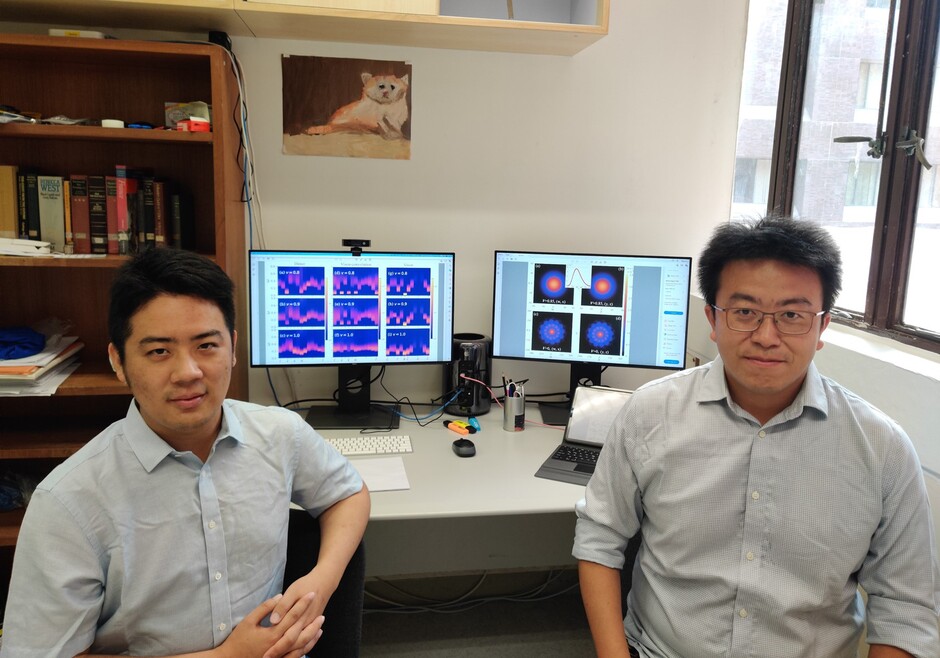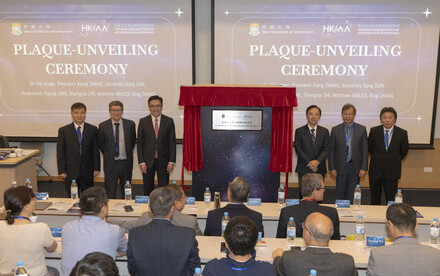29 Apr 2021
HKU physicists developed a new algorithm solving a long standing problem in constrained quantum material models

Postdoctoral Fellow Dr Zheng YAN(on the left) and Associate Professor Dr Zi Yang MENG, from the HKU Research Division for Physics have invented a new algorithm that could solve a large class of important constrained quantum material models.
The intrinsic scale limit of current quantum material hinders possible development of technology, thus the discovery of a new generation of quantum materials holds the key to technological revolutions, such as stable topological quantum computers, high-temperature superconductors, high capacity information and energy storage. Nevertheless, due to their nature of strongly correlated electrons, it is not uncommon for the next generation of quantum materials to have extremely complex interactions with the environment, making it difficult to study their properties and to make use of them.
Scientists are working proactively to learn how this next generation of quantum materials could reach and remain stable at topological phase and how to make use of their excited particles. Recently, Postdoctoral Fellow Dr Zheng YAN and Associate Professor Dr Zi Yang MENG, from the Research Division for Physics and Astronomy of the Faculty of Science at the University of Hong Kong (HKU), have invented a new algorithm that could solve a large class of important constrained quantum material models, via powerful supercomputer combined with theoretical analysis. They also teamed up with Dr Yancheng WANG from China University of Mining and Technology, Dr Nvsen MA from Beihang University, and Professor Yang QI from Fudan University to employ the algorithm and untangle a long-standing puzzle of a typical constrained quantum materials model, ‘quantum dimer model’.
Their study reveals the unique non-trivial interaction among ‘visons’, a mysterious particle which is excited in a topological order which carries finite emergent flux, and uncover the real property of this useful particle which may push ahead the development of technological innovation. The research findings are recently published in the renowned academic journal npj Quantum Materials.
Background
Many modern technologies are based on the quantum nature of materials, such as silicon-based computers, solar cells or lithium-ion batteries. These current generation quantum materials all belong to the category of weakly-correlated systems, where the interactions between electronic degrees of freedom are not dominant and are not sensitive to their environment, hence, they are reasonably easier for scientists to study their properties. On the other hand, the next generation quantum materials based on strong correlations between electrons (they are also denoted as quantum many-body systems) are becoming more crucial for the development of modern technologies as well as for addressing the major challenges in our society. For instance, the 2D quantum moiré materials, a type of next generation quantum material, can be used as magic angle twisted bilayer graphene, the next-generation AI computing chips that go beyond Moore’s law, the high-temperature superconductor for lossless energy transmission and high-speed Maglev train, and the quantum frustrated magnets and topological unit for quantum computers and quantum information, etc.
However, due to the intrinsic exponential complexity of the underlying quantum many-body problem, that scientists have to solve millions of thousands of the electrons in the material in a quantum mechanical way, these complicated systems require modern computational techniques and advanced numerical analysis to reveal their microscopic mechanisms. Indeed, the need for inventing better algorithm and simulation of quantum materials for validating microscopic models as well as to guide experiments, has stimulated the development of novel theoretical and numerical concepts and techniques beyond the frontiers of the existing knowledge, and to discover better materials to benefit our society.
Quantum dimer model and sweeping cluster Monte Carlo method
To study the properties of these quantum many-body materials, scientists first need to build proper models for the next generation quantum materials and solve their properties at different conditions (differ phases, response in temperature, pressure, electric and magnetic fields, etc.) via large-scale simulations on supercomputers and analyse the results by advanced physics and mathematics tools, then adjust the model parameters to fit in the experimental observations and make predictions for future experiments.

Figure 1. Building models for the next generation quantum materials: (a) the triangular lattice quantum dimer model (QDM). (b) The solid hexagon and dashed rectangle are the Brillouin zone (BZ) for the dimer and vison. (c) Phase diagram of triangular QDM.
Among these quantum many-body models, there exist a large class of dubbed constrained models, in which not only the electrons experience the mutual quantum interactions with millions of other electrons, their unique existence in model and material are further constrained by certain strict rules that further limit their movements. Such constraints at the first appearance look unphysical, but they are the key ingredients of establishing the novel material properties, as the constraints could filter unwanted (usually high-energy) excitations that mask the fragile quantum nature and help us to directly access the low-energy physics with pure quantum entanglement. For example, it has been long anticipated that one such constrained model, triangular lattice quantum dimer model, could give rise to the topological phase of matter, in which the excitations therein are the building blocks to realise topological quantum computer and computation.
Unfortunately, such constrained quantum model still cannot be simulated without approximation with modern numerical approaches. This is because due to the constraints, all the simulations should work in a restricted space. It is like a speeding car on a narrow and winding road without hitting the banks. The HKU team finally manages to change the situation by inventing and employing a new algorithm – the sweeping cluster quantum Monte Carlo algorithm – to fully solve the triangular lattice quantum dimer model.

Figure 2. Spectra of dimer, vison-convolution and vison of the triangular quantum dimer model. These are only possible from the new simulation algorithm invented by the HKU team
New discovery of topological excitations which carries long range quantum entanglement
Using the new algorithm and from their simulations on the Tianhe-II supercomputer, the research team found clear quantum entangled excitations (scientifically called vison and dimer excitations) without the interference of high-energy excitation. Vison is a mysterious particle that oftens appear in pairs, and is difficult to detect a single vison in ordinary models. It is a kind of emergent article (anyons) excited in a topological order which carries finite emergent flux. Via the new developed algorithm, the HKU team could compute the spectrums of single vison, dimer (coupled visons in real model), vison-convolution (also known as VC; visons with weak interaction) as shown in Fig.2. It is interesting to notice that the VC spectral gap at M point is higher than the dimer gap at the same point, suggesting that visons actually have a binding energy in forming the dimer correlation and consequently their interaction effect is attractive and gives rise to a bound state with lower energy than the naive convolution. Through this study, they reveal the unique non-trivial interaction among the mysterious visons.

Figure 3. (a), (b), (c) and (d) are the projection of the four-dimensional order parameter at the QSL-VBS critical point with on the two-dimensional planes. (Inset) The density distribution per unit sphere area of the O(4) order parameter modulus at critical point, such radial dependence reveals that the order parameter indeed form a four-dimensional sphere. From (a) (b) to (c) (d), order parameter changes from being uniformly distributed to being more concentrated on some points, which means vison condensation.
Furthermore, the research group also found emergent continuous symmetry at the phase transition from the topological phase to a solid phase in the model as shown in Fig.3. From (a), (b) and inset figures, it is clear a 4D sphere histogram and radius is conserved. Through the simulation, researchers further saw that vison condenses on certain points on a four-dimensional sphere in the order parameter space as (c) and (d) shown to prove the results of the previous predictions made by theorists. This reveals the mechanism of vison condensation and critical point.
New algorithm brings new opportunity
This finding helps scientists to understand the behaviour and interaction of anyons in the topological order, which might have potential applications in future quantum information technologies. With the powerful new algorithms and the unique properties of topological excitations discovered, many interesting research and potential applications with topological quantum materials can be pursued from here.
Dr Meng remarked, “The new algorithm for constrained quantum models and their solutions of topological excitations will eventually bring benefits to society, such that these visons are the information carrier for quantum computation and quantum computers. Our algorithm enables us to directly access numerical results with key theoretical predictions quantitatively, which is not possible before. Such efforts will certainly lead to more profound and impactful discoveries in quantum materials.”
About Dr Zheng Yan and Dr Zi Yang Meng
Dr Zheng Yan is currently a postdoctoral fellow at Dr Meng’s quantum simulation group. He invented the original version of the sweeping cluster quantum Monte Carlo method during his PhD study in Fudan University.
Dr Zi Yang Meng is an expert in Monte Carlo simulation of quantum many-body systems, and has recently made the breakthrough in quantum material research. He was awarded the “2020 Tianhe Star Award” by the National Supercomputer Center of China for his outstanding accomplishments and promotion of computational oriented research on the Tianhe supercomputer.
Professor Yang QI of Fudan University performed the quantum field theory analysis of the numerical results and made sense of it all.
The work was supported by the Research Grants Council of HKSAR, the Ministry of Science and Technology of China and the National Science Foundation of China.
The journal paper at npj Quantum Materials can be accessed here.






